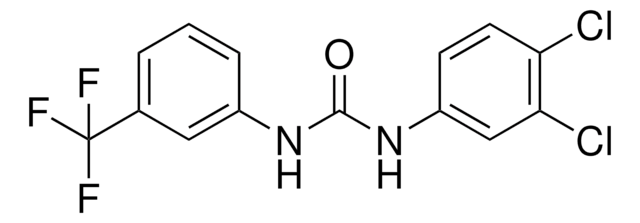114510
Methyl Orange
ACS reagent, Dye content 85 %
Sinónimos:
4-[4-(Dimethylamino)phenylazo]benzenesulfonic acid sodium salt, Acid Orange 52, Helianthin, Orange III
About This Item
Productos recomendados
grade
ACS reagent
Quality Level
form
powder
composition
Dye content, 85%
technique(s)
titration: suitable
color
orange
pH
3.0-4.4, pink to yellow
visual transition interval
3.2-4.4, red to yellow
mp
>300 °C
λmax
505 nm
application(s)
diagnostic assay manufacturing
hematology
histology
storage temp.
room temp
SMILES string
[Na+].CN(C)c1ccc(cc1)\N=N\c2ccc(cc2)S([O-])(=O)=O
InChI
1S/C14H15N3O3S.Na/c1-17(2)13-7-3-11(4-8-13)15-16-12-5-9-14(10-6-12)21(18,19)20;/h3-10H,1-2H3,(H,18,19,20);/q;+1/p-1/b16-15+;
InChI key
STZCRXQWRGQSJD-GEEYTBSJSA-M
¿Está buscando productos similares? Visita Guía de comparación de productos
Categorías relacionadas
General description
Application
- pH indicator in the cell sap
- counterstain to crystal violet in staining pollen tubes
- component of a polychrome histological stain
- solution indicator, such as in assays of oxalic and malonic acids
- in other biomedical applications that include use in film dosimeters and as a reagent for the assay of bromide ions.
Biochem/physiol Actions
signalword
Danger
hcodes
Hazard Classifications
Acute Tox. 3 Oral
Storage Class
6.1C - Combustible acute toxic Cat.3 / toxic compounds or compounds which causing chronic effects
wgk_germany
WGK 3
flash_point_f
Not applicable
flash_point_c
Not applicable
ppe
Eyeshields, Faceshields, Gloves, type P2 (EN 143) respirator cartridges
Elija entre una de las versiones más recientes:
¿Ya tiene este producto?
Encuentre la documentación para los productos que ha comprado recientemente en la Biblioteca de documentos.
Los clientes también vieron
Nuestro equipo de científicos tiene experiencia en todas las áreas de investigación: Ciencias de la vida, Ciencia de los materiales, Síntesis química, Cromatografía, Analítica y muchas otras.
Póngase en contacto con el Servicio técnico







